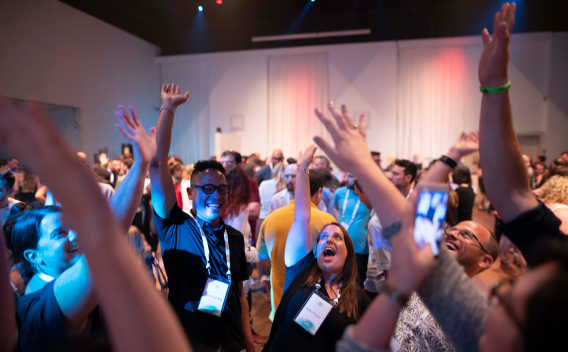By
Published
November 9, 2020
Tags
We are deep into an unforeseen season of virtual events. By now, we know that truly awesome online engagement opportunities are possible. But we also know that they don’t just happen—impactful virtual events are crafted and intentionally translated to make the most of their format.
No doubt some offerings over the past few months have gone off without a hitch; the technology worked well, the content was engaging and participants got a chance to connect with each other. Of course, other events have been a bit awkward. Attendees may not have known what to expect or how to engage. Delays, difficulties and confusion may have left people feeling hesitant to fully immerse themselves in the experience.
The good news is that according to our Virtual Engagement Research report, developed in partnership with the Jim Joseph Foundation and Benenson Strategy Group, there are certain steps organizers can take to help vanquish any awkwardness and set the stage for a meaningful event. While our research looked specifically at the needs and preferences of Jewish young adults, we believe the findings are representative of young adults more broadly.
Here are five tips for helping participants feel welcome, comfortable and engaged:
1. Take fun seriously.
One of the most surprising findings from our research is what an important role fun plays for participants. According to our young adult respondents, “It seemed like fun” was the most common reason for logging on to a virtual engagement opportunity. We also found that 52% of respondents had postponed a major life event, decision or transition due to the pandemic and that 66% of respondents were experiencing heightened depression due to job loss, isolation and other challenges. With these statistics in mind, it makes sense that opportunities for reprieve are welcome diversions from the hardship many young adults are experiencing.
Practically speaking, that means weaving in a sense of playfulness when appropriate. Note that even events focused on serious issues can sometimes benefit from lighter moments. You might consider incorporating creative icebreakers into the agenda: using a playful tone for introductions and content, hosting an event simply for its ability to make people smile or ensuring a social aspect so that fun topics can lead to meaningful connections.
2. Facilitate connection among participants.
If there was one thing that came across loud and clear in our research, it is that young Jewish adults are eager for community. In this time of social distancing, people miss being with friends, family and loved ones in casual settings—so they are looking to recreate that feeling online. As one respondent shared, “I think the main thing is to feel connected and a part of something while we are all in isolation...I do miss the feel of a community.” Indeed, 65% of respondents described feeling disconnected, while 84% either agreed or strongly agreed that it was important to connect with others during this time. Virtual events can be an effective way to do this, especially if there are user-friendly options for interacting with other participants.
Practically speaking, that means adding interactive elements to your event. You might consider offering small group breakout sessions, making thoughtful use of chat functions, providing participants with ways to connect personally or in small groups before, during and/or after the event and following up with ways for participants to stay connected or get more involved.
3. Speak to people’s interests.
Over the past few months, many people have turned to creative hobbies as a way to fill time and tend to their mental health. The same is true for Jewish young adults—they are spending more time cooking, watching movies and even experimenting with new Jewish rituals. Our research showed that successful events support participants in discovering new insights, discussing an issue they care about and walking away with something they can incorporate into their lives after the event, be it a new idea, ritual, skill, recipe or playlist.
Practically speaking, that means providing participants with special, high-quality content related to a chosen interest. For example, The Great Big Jewish Food Fest offered participants the chance to tour Jewish delis across the country and cook alongside famous chefs who joined from their home kitchens in Tel Aviv, Philadelphia and New York City. The event offered the 20,000 attendees entertainment and practical skills, as well as exclusive access to something they wouldn’t otherwise be able to do. As one participant said, “It lifted my spirits and provided content that was interesting and informative. The programs inspired me to re-read Jewish recipes and recipes in general that my mom had handwritten and passed on to me…It brought me closer to my Jewish roots and identity through food.”
4. Establish norms for your virtual world.
Of course, execution is just as important as content. Respondents shared anecdotes of finding virtual events overwhelming, awkward or anxiety-inducing—which makes sense given that online gatherings often lack the casual, emergent cadence of being in a room together. To help young people feel more comfortable, planners must go out of their way to establish norms and social cues. While doing so may feel unnatural, it will help everyone feel more comfortable in an online setting.
Practically speaking, that means making sure everyone knows who is in the room, the order in which things will occur and what is expected of participants at each point along the way. You might consider practices such as leading formal introductions, posting a list of participants, indicating whose turn it is to speak next, reviewing instructions before heading into breakout rooms and letting participants know when and how to ask questions.
5. Account for Zoom fatigue.
Let’s be honest; for many of us, the novelty of “Zoom” events has worn off. Zoom fatigue is particularly acute among those under 30, with 40% of 18-29 year-olds saying they are feeling sick of Zoom and other online video platforms. One way to circumvent Zoom fatigue is to account for common pitfalls, such as events that go on too long, technological difficulties or disorganized or unclear agendas.
Practically speaking, that means thinking through the experience from a participant’s perspective. You might consider reaching out to your video platform representative to familiarize yourself with display, chat and breakout functions, sending an event agenda and guidelines in advance, giving your event (and event materials) a personality from start to finish and choosing an energetic and personable emcee.
For program organizers, creating a rewarding event takes thoughtful consideration and planning—and our research indicates that the effort is well worth it; the more worthwhile an event feels to an attendee, the more likely they are to seek out and participate in similar offerings.
As we continue to reap the benefits of virtual programming—including accessibility, low-barrier to entry and cost—it is likely that virtual events may find a more significant home in our annual programming beyond the pandemic. There is no time like the present to experiment and tweak our virtual programs to make them as effective as possible, leaving our participants feeling informed, connected, happy and ready for the next event.
Download our Virtual Engagement Research Findings and get sample questions for evaluating your virtual event.






